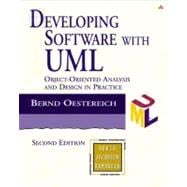
Note: Supplemental materials are not guaranteed with Rental or Used book purchases.
Purchase Benefits
What is included with this book?
| Preface | p. ix |
| Introduction | p. 1 |
| Object-oriented Software Development | p. 2 |
| History of Object-orientation | p. 3 |
| OOAD in Practice | p. 8 |
| Holistic Approach | p. 11 |
| Object-orientation for Beginners | p. 17 |
| Object-orientation for Beginners | p. 18 |
| Classes, Objects, Instances | p. 19 |
| Attributes, Operations, Constraints, Relationships | p. 20 |
| Object Identity | p. 22 |
| Responsibilities | p. 24 |
| Taxonomy and Inheritance | p. 25 |
| Abstract Classes | p. 34 |
| Associations | p. 35 |
| Aggregations | p. 35 |
| Message Exchange | p. 39 |
| Collections | p. 42 |
| Polymorphism | p. 44 |
| Persistence | p. 47 |
| Classification of Classes | p. 50 |
| Design Patterns | p. 56 |
| Components | p. 58 |
| Analysis | p. 63 |
| Introduction | p. 64 |
| Developing the System Idea and Objective | p. 64 |
| Identifying Stakeholders | p. 65 |
| Identifying Business Processes | p. 68 |
| Identifying Stakeholders' Interests | p. 70 |
| Identifying Business Use Cases | p. 72 |
| Describing the Essence of Use Cases | p. 76 |
| Identifying System Use Cases | p. 82 |
| Collecting and Studying Materials | p. 87 |
| Describing the Requirements | p. 89 |
| Identifying Business Classes | p. 92 |
| Creating a Technical Dictionary | p. 94 |
| Developing a Use Case Process Model | p. 99 |
| Describing the System Interface | p. 104 |
| Explorative Interface Prototyping | p. 108 |
| Design | p. 113 |
| Defining the Application Architecture | p. 114 |
| Identifying Domain Components | p. 118 |
| Developing Component-specific Class Models | p. 120 |
| (Further) Developing State Models | p. 123 |
| Identifying and, if Necessary, Restructuring Component Dependencies | p. 125 |
| Designing Component Interfaces | p. 127 |
| Developing Collaboration Models | p. 129 |
| Developing Process-oriented Component Tests | p. 132 |
| Developing Class Tests | p. 135 |
| Defining Attributes | p. 138 |
| Specifying Dialogs | p. 142 |
| Discussion of Design | p. 145 |
| UML Fundamentals | p. 157 |
| Introduction | p. 158 |
| Types of Diagrams | p. 160 |
| Use Case Diagrams | p. 161 |
| Class Diagrams (Basic Elements) | p. 172 |
| Class Diagrams (Relational Elements) | p. 219 |
| Behavioral Diagrams | p. 250 |
| Implementation Diagrams | p. 272 |
| Appendices | p. 275 |
| Glossary | p. 277 |
| References | p. 289 |
| Index | p. 293 |
| Table of Contents provided by Syndetics. All Rights Reserved. |
The New copy of this book will include any supplemental materials advertised. Please check the title of the book to determine if it should include any access cards, study guides, lab manuals, CDs, etc.
The Used, Rental and eBook copies of this book are not guaranteed to include any supplemental materials. Typically, only the book itself is included. This is true even if the title states it includes any access cards, study guides, lab manuals, CDs, etc.